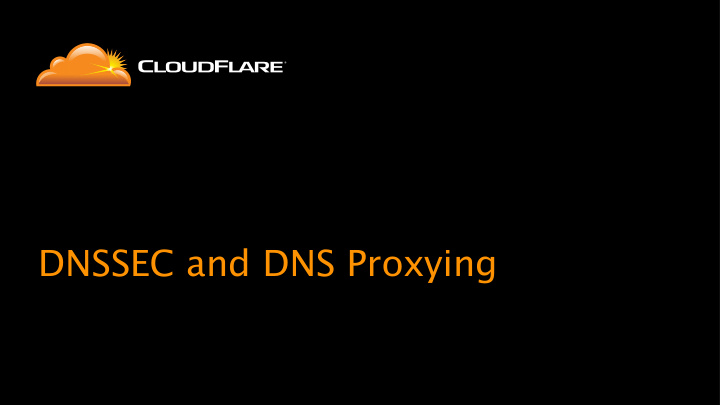



DNSSEC and DNS Proxying
DNS is hard • at scale • when you are a huge target 2
CloudFlare DNS • is big 3
CloudFlare DNS • is fast 4
CloudFlare DNS • is always under attack 5
CloudFlare • A secure reverse proxy for http(s) • Change your SOA to us • We will point your A records to us • We need internal and external DNS to keep track 6
CloudFlare • DNS Resolver � • Q: Who is something.com? → CloudFlare External DNS • A: CloudFlare Proxy IP 7
CloudFlare • Web browser � • Hi something.com, get me index.html → CF Proxy IP • CF proxy: do I have index.html cached? No. • CF proxy: who is something.com, really? → CF Internal DNS • CF Internal DNS: origin IP → CF proxy • CF proxy: Hi something.com, get me index.html → Origin IP • Origin IP: index.html → CF proxy • CF proxy: index.html → Web browser 8
CloudFlare External DNS • Deals with attempted DDoS constantly • Huge DNS floods of legitimate requests • 50+ million packets per second to one location • Large volumetric reflection attacks • 300+ Gbps DNS reflection (2013, Spamhaus) • 400+ Gbps NTP reflection (2014) 9
CloudFlare External DNS • Standard RRL not enough, need special filters • String matching • Length matching • Statistical approach: heavy hitters • Regular expressions 10
CloudFlare External DNS • Other special feature: CNAME flattening • Following CNAME records is slow • Can’t CNAME the zone apex � • Solution: Follow CNAME chain, transform into A or AAAA record 11
What to do? • How did we solve HTTP DDoS? • Anycast and a reverse proxy (nginx) � • How do we solve DNS DDoS? • Write your own DNS server? Maybe • Create a DNS reverse proxy? YES 12
What to do? • RRDNS: a DNS reverse proxy in Go � • Why Go? • compiled language gives great performance • built-in concurrency • easy to write, maintain, and make modular 13
What does it do? • Acts as a transparent reverse proxy in front of an authoritative server � • Not a recursive nameserver • Filters bad/spoofed requests, caches, load balances • Returns the authoritative bit • Responses look like ones from authoritative server 14
More advantages • Highly dynamic • Does not use zone files • Automation reduces cost for operator 15
How we use it • RRDNS handles both internal and external DNS • Filter model inspired by nginx • SSL • WAF • Business logic • Cache • Upstream 16
How we use it • RRDNS filter • front-line rate limit filtering • length & string matching, heavy hitter, IP reputation, geolocation, truncation test, etc. • request type filtering (limit to A, AAAA, CNAME, MX, etc.) • caching layer • optional authoritative module (for internal DNS) • upstream DNS resolution (for cache misses and CNAME resolution) 17
Where does DNSSEC fit in? • Do it yourself behind the reverse proxy • Let RRDNS take care of it 18
Pure Proxy DNSSEC • Upstream manages all DNSSEC related data • NSEC or NSEC3 records computed and served by upstream • CloudFlare Internal DNS upstream: • Centralized o ffm ine signing with zone distribution over encrypted KV store � • Problems: CNAME flattening signatures unavailable • Questions: Should proxy validate signatures from upstream? 19
Zone Enumeration • NSEC or NSEC3 records computed o ffm ine • Zone enumeration possible with NSEC • O ffm ine dictionary attack with NSEC3 � • We want zone privacy, and CNAME flattening • Solution: Live signing 20
Hybrid DNSSEC • Upstream creates full DNSSEC zone (including NSEC3 records) • Centralized o ffm ine signing with zone distribution over encrypted KV store • KSK, ZSK1 used for o ffm ine signing (long lived) • ZSK2 used for online signing of CNAME and NSEC3 white lies (short- lived) • Under DDoS • serve real NSEC3 record • disable CNAME flattening 21
DNS Reverse Proxy as a service • Large authoritative nameservers need Cloud DDoS protection, acceleration, caching • Put CloudFlare/RRDNS in front � • What if they don’t want to set up DNSSEC? • Use RRDNS live signing! 22
Live DNSSEC • Upstream creates regular non-DNSSEC zone • KSK created centrally, DNSKEY RRSIG distributed to edge • ZSK created centrally, distributed to edge servers via TPM binding • ZSK used for live signing of all records • Flattened CNAME and NSEC3 white lies • Live signatures stored in shared cache within a colocation • CloudFlare integration with registrar 23
Result • Authoritative servers get DDoS protection and acceleration • Works with already integrated DNSSEC solution • Or flip a switch and get DNSSEC automatically 24
Conclusion • DNS is hard • DNSSEC is hard • Special problems require custom solutions � • Let us do DNSSEC for you • But first: we have lots of work to do 25
Recommend
More recommend